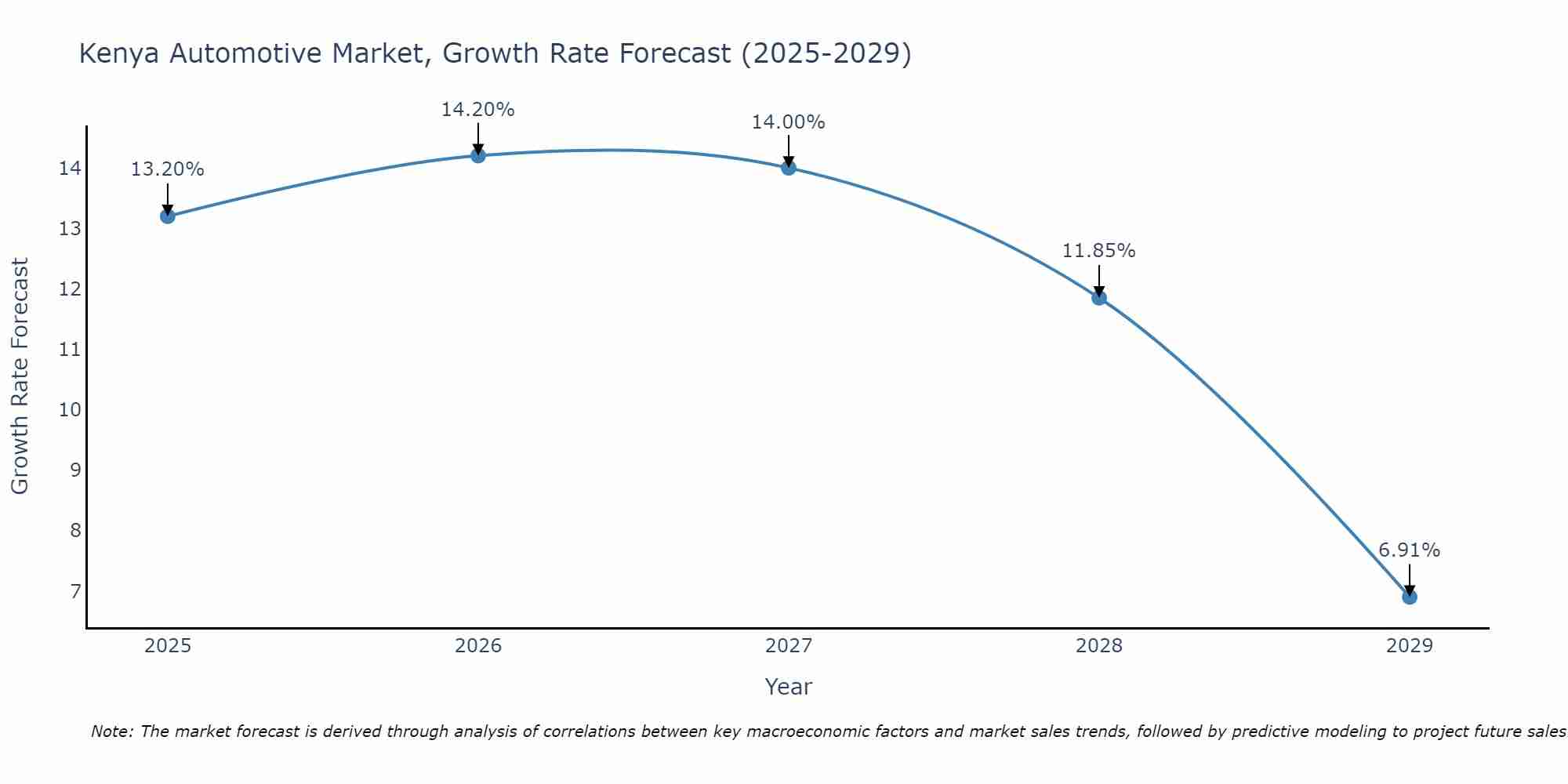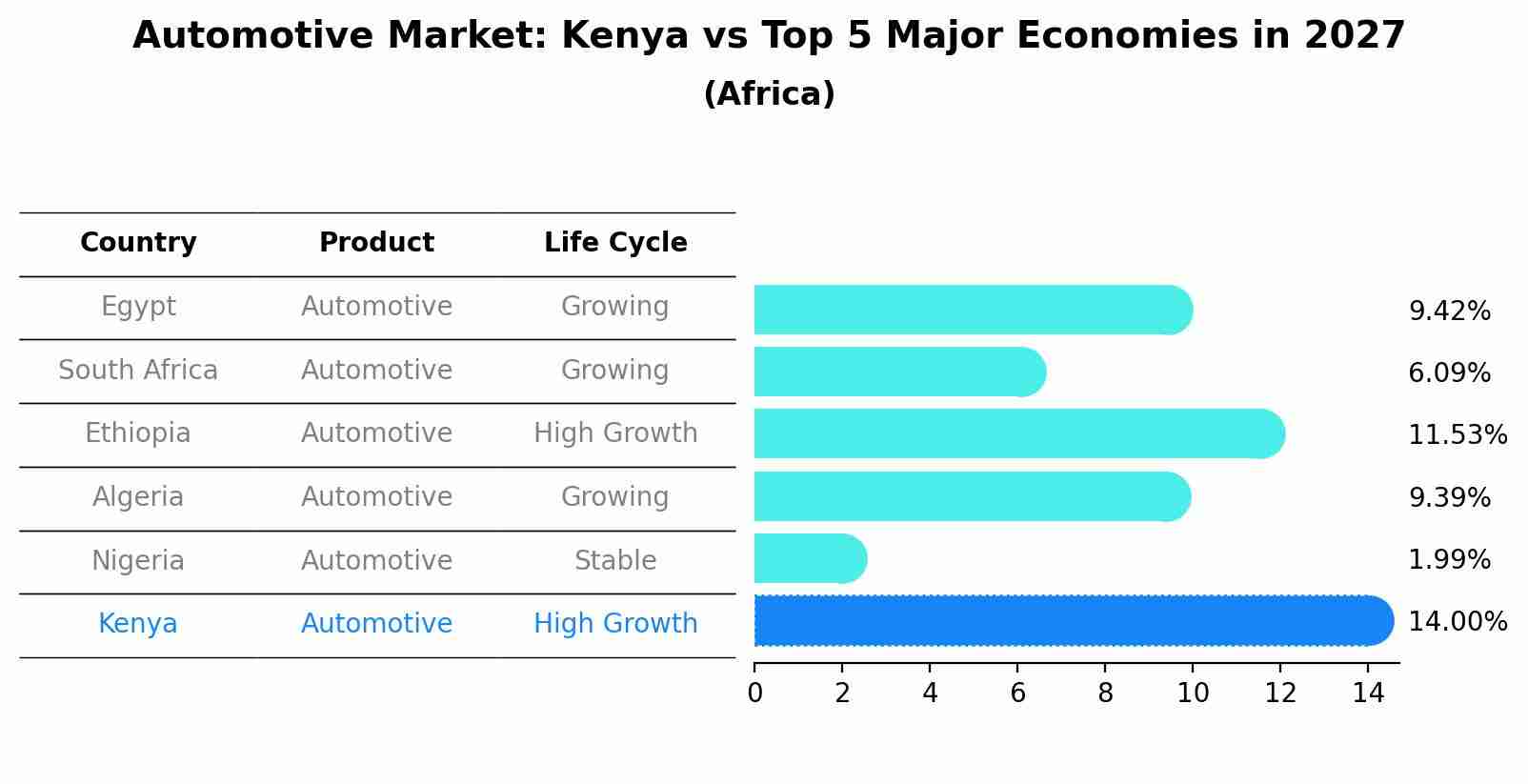Kenya Automotive Market Outlook | Share, Industry, Growth, Size, COVID-19 IMPACT, Forecast, Value, Companies, Trends, Analysis & Revenue
| Product Code: ETC431806 | Publication Date: Oct 2022 | Updated Date: Jul 2025 | Product Type: Market Research Report | |
| Publisher: 6Wresearch | Author: Vasudha | No. of Pages: 75 | No. of Figures: 35 | No. of Tables: 20 |
Kenya Automotive Market Size Growth Rate
The Kenya Automotive Market is projected to witness mixed growth rate patterns during 2025 to 2029. Starting at 13.20% in 2025, the market peaks at 14.20% in 2026, and settles at 6.91% by 2029.

Automotive Market: Kenya vs Top 5 Major Economies in 2027 (Africa)
The Automotive market in Kenya is projected to grow at a high growth rate of 14.00% by 2027, highlighting the country's increasing focus on advanced technologies within the Africa region, where Egypt holds the dominant position, followed closely by South Africa, Ethiopia, Algeria and Nigeria, shaping overall regional demand.

Kenya Automotive Market Synopsis
The Kenya Automotive Market is experiencing steady growth driven by increasing disposable incomes, urbanization, and a growing middle class. Passenger vehicles dominate the market, with a preference for compact SUVs and hatchbacks due to their fuel efficiency and versatility. Japanese brands such as Toyota, Nissan, and Honda are popular choices among Kenyan consumers for their reliability and affordability. The commercial vehicle segment is also expanding, fueled by demand from the logistics and construction industries. Challenges in the market include high import duties, inadequate infrastructure, and a lack of financing options. However, initiatives to promote local assembly and the development of a supportive regulatory framework are expected to drive further growth in the Kenya Automotive Market.
Kenya Automotive Market Trends
The Kenya Automotive Market is experiencing several trends, including a growing demand for affordable and fuel-efficient vehicles due to rising fuel prices and the increasing focus on environmental sustainability. The market is also seeing a shift towards electric vehicles and hybrid cars as consumers become more eco-conscious. Additionally, there is a rising interest in advanced safety features and connectivity options in vehicles, driven by the need for enhanced safety and convenience. The market is also witnessing the emergence of car-sharing and ride-hailing services, reflecting changing consumer preferences towards shared mobility solutions. Overall, the Kenya Automotive Market is evolving to meet the demands of a modern and environmentally conscious consumer base.
Kenya Automotive Market Challenges
The Kenya Automotive Market faces various challenges, including high import tariffs and taxes on vehicles, which drive up prices and hinder consumer affordability. Additionally, inadequate infrastructure, such as poor road conditions and limited access to maintenance services, affects the overall growth of the market. The prevalence of counterfeit spare parts also poses a significant challenge, leading to safety concerns and reduced trust in the quality of vehicles. Moreover, the lack of government incentives for local automotive manufacturing and limited access to financing options further constrain market expansion. Addressing these challenges will be crucial for the Kenya Automotive Market to reach its full potential and attract more investments for sustainable growth.
Kenya Automotive Market Investment Opportunities
The Kenya automotive market presents promising investment opportunities due to factors such as a growing middle class, increasing urbanization, and government initiatives to enhance infrastructure. Opportunities exist in areas such as vehicle assembly plants, spare parts manufacturing, dealership networks, and after-sales services. With the demand for new and used vehicles on the rise, investing in car rental services, ride-sharing platforms, and electric vehicles also hold potential for growth. Additionally, leveraging technology for innovations in areas like vehicle tracking systems, auto insurance, and online marketplaces for automotive products can provide lucrative investment prospects in the evolving Kenyan automotive market. Partnering with local stakeholders, understanding consumer preferences, and keeping abreast of regulatory changes will be key to maximizing returns in this dynamic sector.
Jordan Agar Market Government Policies
The Kenyan government has implemented several policies to support the growth of the automotive market in the country. These include the reduction of import duties on vehicles to promote affordability, the establishment of the National Automotive Policy to guide the industry`s development, and the implementation of vehicle age limits to encourage the purchase of newer and safer vehicles. Additionally, the government has introduced incentives for the local assembly of vehicles to promote domestic production and create job opportunities. These policies aim to stimulate growth in the automotive sector, improve road safety, and enhance the overall competitiveness of the industry in Kenya.
Kenya Automotive Market Future Outlook
The future outlook for the Kenya Automotive Market appears promising, driven by factors such as a growing middle-class population, urbanization, and increasing disposable incomes. The government`s focus on infrastructure development and improving road networks is also expected to boost the demand for vehicles in the country. Additionally, the rising awareness of environmental sustainability is likely to drive the adoption of electric and hybrid vehicles in the market. However, challenges such as high import tariffs, fluctuating exchange rates, and potential regulatory changes could impact the market`s growth. Overall, with the right strategies and investments in place, the Kenya Automotive Market is poised for steady growth in the coming years.
Key Highlights of the Report:
- Kenya Automotive Market Outlook
- Market Size of Kenya Automotive Market, 2021
- Forecast of Kenya Automotive Market, 2031
- Historical Data and Forecast of Kenya Automotive Revenues & Volume for the Period 2018 - 2031
- Kenya Automotive Market Trend Evolution
- Kenya Automotive Market Drivers and Challenges
- Kenya Automotive Price Trends
- Kenya Automotive Porter's Five Forces
- Kenya Automotive Industry Life Cycle
- Historical Data and Forecast of Kenya Automotive Market Revenues & Volume By Product Type for the Period 2018 - 2031
- Historical Data and Forecast of Kenya Automotive Market Revenues & Volume By Electric for the Period 2018 - 2031
- Historical Data and Forecast of Kenya Automotive Market Revenues & Volume By Hybrid Electric for the Period 2018 - 2031
- Historical Data and Forecast of Kenya Automotive Market Revenues & Volume By Plug-In Hybrid Electric for the Period 2018 - 2031
- Historical Data and Forecast of Kenya Automotive Market Revenues & Volume By Mild Hybrid for the Period 2018 - 2031
- Historical Data and Forecast of Kenya Automotive Market Revenues & Volume By Natural Gas for the Period 2018 - 2031
- Historical Data and Forecast of Kenya Automotive Market Revenues & Volume By Fuel Cell Electric for the Period 2018 - 2031
- Historical Data and Forecast of Kenya Automotive Market Revenues & Volume By Diesel for the Period 2018 - 2031
- Historical Data and Forecast of Kenya Electric Automotive Market Revenues & Volume By Petrol for the Period 2018 - 2031
- Kenya Automotive Import Export Trade Statistics
- Market Opportunity Assessment By Product Type
- Kenya Automotive Top Companies Market Share
- Kenya Automotive Competitive Benchmarking By Technical and Operational Parameters
- Kenya Automotive Company Profiles
- Kenya Automotive Key Strategic Recommendations
Frequently Asked Questions About the Market Study (FAQs):
- Single User License$ 1,995
- Department License$ 2,400
- Site License$ 3,120
- Global License$ 3,795
Search
Thought Leadership and Analyst Meet
Our Clients
Related Reports
- Australia Briquette Market (2025-2031) | Growth, Size, Revenue, Forecast, Analysis, Trends, Value, Share, Industry & Companies
- Vietnam System Integrator Market (2025-2031) | Size, Companies, Analysis, Industry, Value, Forecast, Growth, Trends, Revenue & Share
- ASEAN and Thailand Brain Health Supplements Market (2025-2031) | Strategy, Consumer Insights, Analysis, Investment Trends, Opportunities, Growth, Size, Share, Industry, Revenue, Segments, Value, Segmentation, Supply, Forecast, Restraints, Outlook, Competition, Drivers, Trends, Demand, Pricing Analysis, Competitive, Strategic Insights, Companies, Challenges
- ASEAN Bearings Market (2025-2031) | Strategy, Consumer Insights, Analysis, Investment Trends, Opportunities, Growth, Size, Share, Industry, Revenue, Segments, Value, Segmentation, Supply, Forecast, Restraints, Outlook, Competition, Drivers, Trends, Demand, Pricing Analysis, Competitive, Strategic Insights, Companies, Challenges
- Europe Flooring Market (2025-2031) | Outlook, Share, Industry, Trends, Forecast, Companies, Revenue, Size, Analysis, Growth & Value
- Saudi Arabia Manlift Market (2025-2031) | Outlook, Size, Growth, Trends, Companies, Industry, Revenue, Value, Share, Forecast & Analysis
- Uganda Excavator, Crane, and Wheel Loaders Market (2025-2031) | Strategy, Consumer Insights, Analysis, Investment Trends, Opportunities, Growth, Size, Share, Industry, Revenue, Segments, Value, Segmentation, Supply, Forecast, Restraints, Outlook, Competition, Drivers, Trends, Demand, Pricing Analysis, Competitive, Strategic Insights, Companies, Challenges
- Rwanda Excavator, Crane, and Wheel Loaders Market (2025-2031) | Strategy, Consumer Insights, Analysis, Investment Trends, Opportunities, Growth, Size, Share, Industry, Revenue, Segments, Value, Segmentation, Supply, Forecast, Restraints, Outlook, Competition, Drivers, Trends, Demand, Pricing Analysis, Competitive, Strategic Insights, Companies, Challenges
- Kenya Excavator, Crane, and Wheel Loaders Market (2025-2031) | Strategy, Consumer Insights, Analysis, Investment Trends, Opportunities, Growth, Size, Share, Industry, Revenue, Segments, Value, Segmentation, Supply, Forecast, Restraints, Outlook, Competition, Drivers, Trends, Demand, Pricing Analysis, Competitive, Strategic Insights, Companies, Challenges
- Angola Excavator, Crane, and Wheel Loaders Market (2025-2031) | Strategy, Consumer Insights, Analysis, Investment Trends, Opportunities, Growth, Size, Share, Industry, Revenue, Segments, Value, Segmentation, Supply, Forecast, Restraints, Outlook, Competition, Drivers, Trends, Demand, Pricing Analysis, Competitive, Strategic Insights, Companies, Challenges
Industry Events and Analyst Meet
Whitepaper
- Middle East & Africa Commercial Security Market Click here to view more.
- Middle East & Africa Fire Safety Systems & Equipment Market Click here to view more.
- GCC Drone Market Click here to view more.
- Middle East Lighting Fixture Market Click here to view more.
- GCC Physical & Perimeter Security Market Click here to view more.
6WResearch In News
- Doha a strategic location for EV manufacturing hub: IPA Qatar
- Demand for luxury TVs surging in the GCC, says Samsung
- Empowering Growth: The Thriving Journey of Bangladesh’s Cable Industry
- Demand for luxury TVs surging in the GCC, says Samsung
- Video call with a traditional healer? Once unthinkable, it’s now common in South Africa
- Intelligent Buildings To Smooth GCC’s Path To Net Zero


















